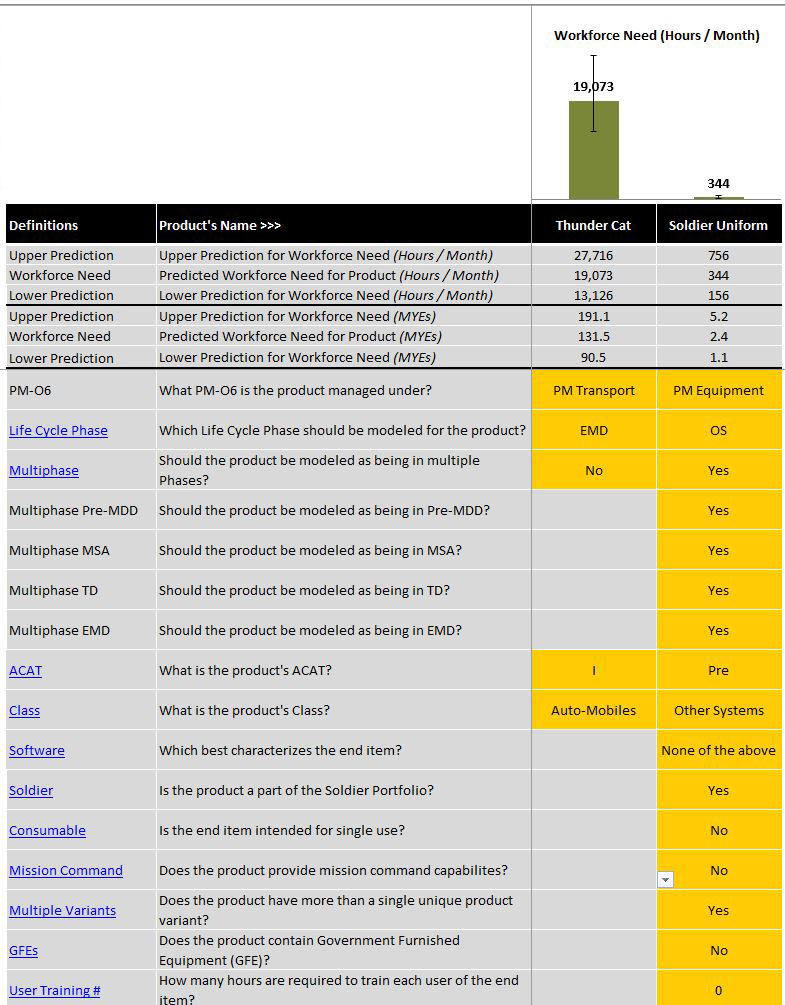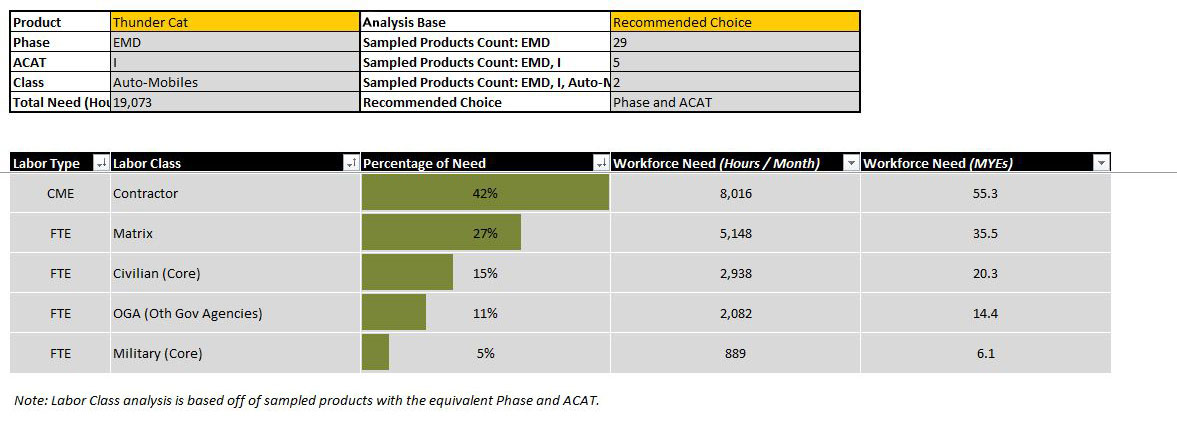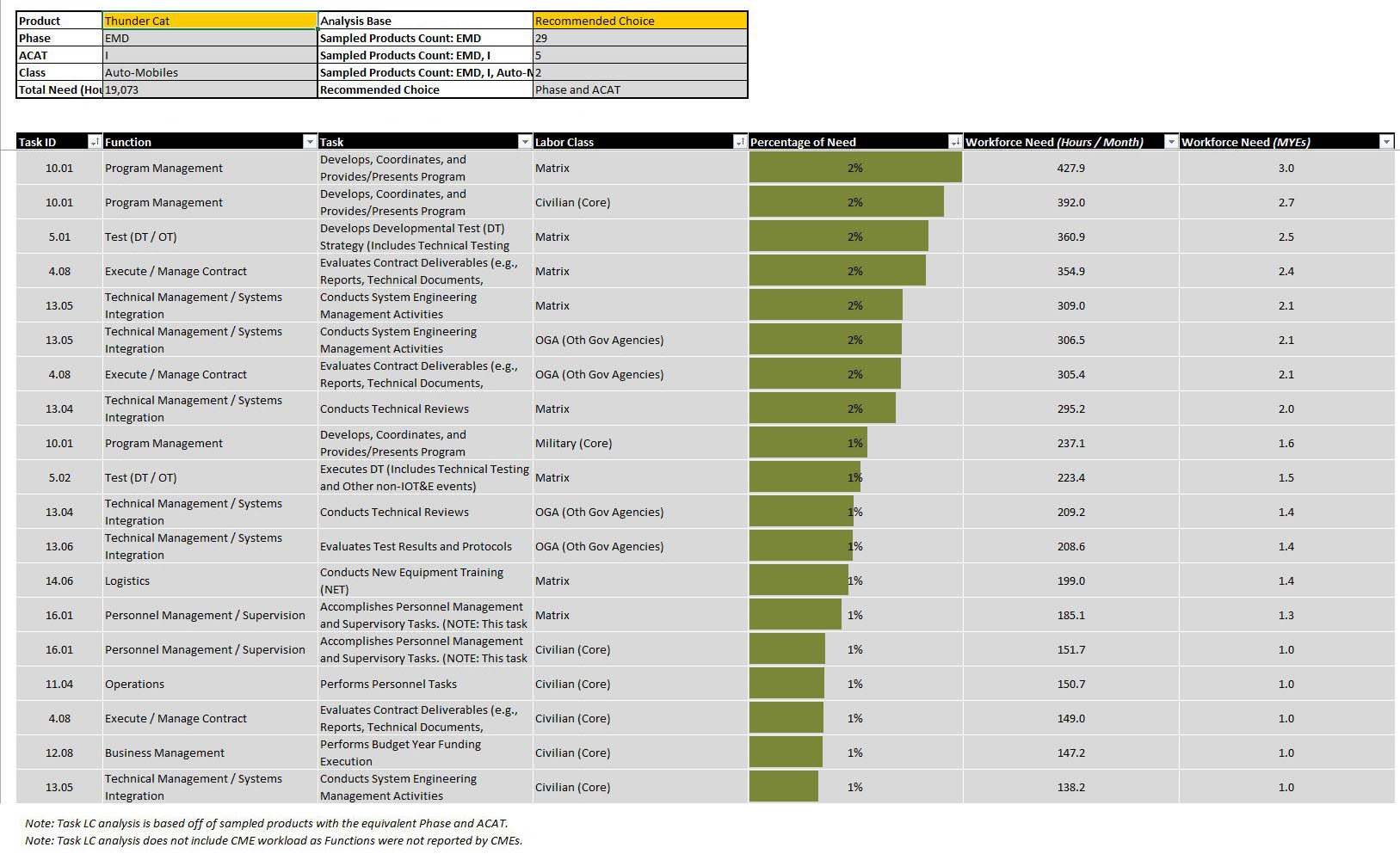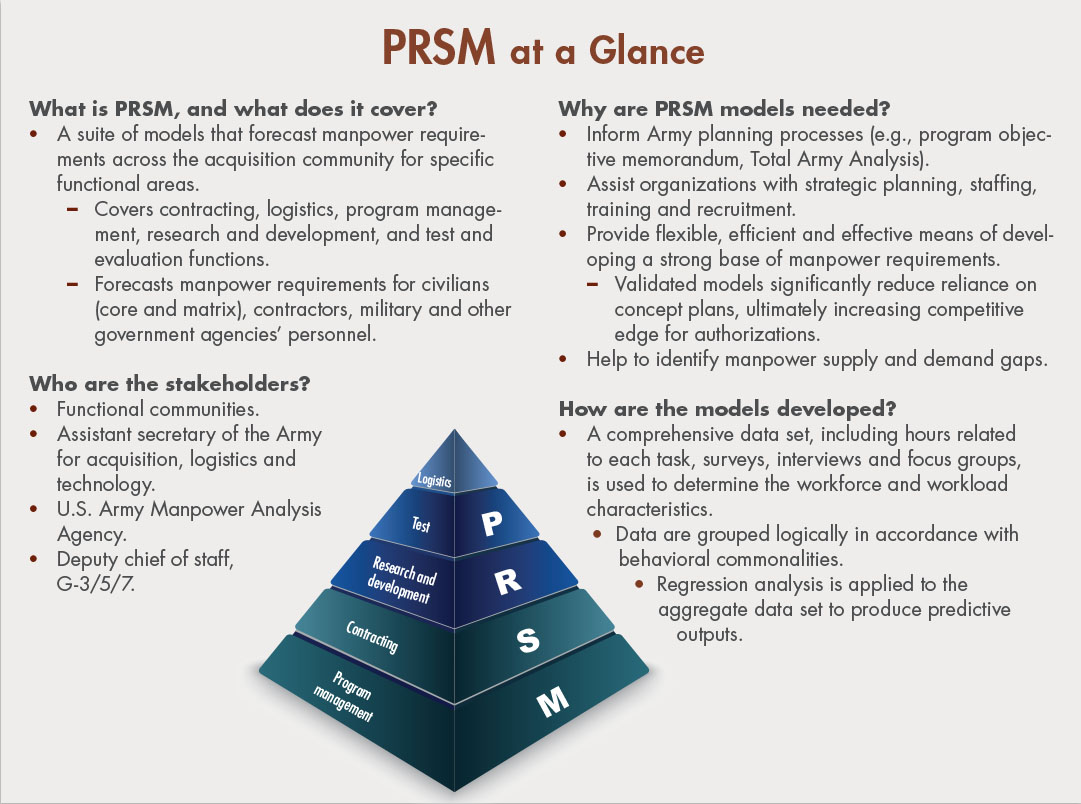
Predictive Resource Staffing Models make staffing a program office easier and faster. A model for the program management community is available now; models for contracting, R&D, T&E and logistics are in development.
by Ms. Rebecca Meyer
You’ve just been selected as the program manager for an up-and-coming system. Congratulations! Its capability promises to revolutionize the way the Soldier operates on the battlefield. It checks all the buzzwords: Lean Six Sigma, cost efficient, auditable. There’s just one problem—a program management office (PMO) has not yet been established to carry out the mission, and you’ve been charged with developing the workforce requirement. Where do you start? How many people will you need? What skill sets will your staff require?
Anyone who has been in this situation can tell you that the thought of standing up a program office is daunting. You’ve asked around, and your fellow program managers relayed to you that they developed their staffing requirements through something called a concept plan. They mentioned that the timeline they experienced for development and approval was quite lengthy, averaging 12 to 18 months. And that doesn’t include using your requirements to request resources in the program objective memorandum (POM). One program manager even told the story of the Mine Resistant Ambush Protected (MRAP) vehicle. MRAP followed the concept plan process to establish its program management office and did not receive approved workforce resources until after the program was already in sustainment. You find yourself asking, “What is this concept plan and why does it take so long?”
“Army Regulation 71-32, Force Development and Documentation” defines a concept plan as a detailed proposal to create or change units at specified thresholds. The purpose is to ensure that requirements are thoroughly reviewed and support Army objectives and priorities, and that HQDA understands the changes. In 2010 guidance, the deputy chief of staff (DCS) G-3/5/7 laid out an eight-step approach to developing, analyzing and presenting manpower staffing requirements through a cost benefit analysis (CBA). Those eight major steps would need to be completed whenever a new program was established or a current program changed significantly.
After the CBA is completed, the U.S. Army Manpower Analysis Agency (USAMAA) and DCS G-3/5/7 validation and approval are required before the requirements can be used in the Army’s resourcing processes. Although the concept plan process works, it does not provide flexibility or time-sensitive results. You begin to wonder why a more streamlined process has not yet been established.
Well, you’re in luck.
Your program executive office (PEO) notifies you that in 2013, the assistant secretary of the Army for acquisition, logistics and technology (ASA(ALT)) began work on a new approach to developing workforce requirements. This approach stemmed from the need to provide flexibility for different levels of programs, identify future requirements and accommodate human resource challenges. From this, the Predictive Resource Staffing Model (PRSM) was born.
DATA IN, FORECAST OUT
PRSM is a suite of five functional-based models developed to provide Army leaders with validated tools to inform resourcing decisions at both the organizational and agency levels. The model outputs, based on sound statistical analysis and input from functional communities, forecast the manpower requirements needed to support Army acquisition programs. Functional areas include program management, contracting, research and development (R&D), test and evaluation (T&E), and logistics.
Each functional PRSM is developed individually, based on the critical factors and workload drivers most relevant to the population being modeled. Workload factors and drivers are determined based on the organization’s mission, input from functional subject matter experts, policy, business processes and workload trends.
Remember those eight major steps required to build the concept plan? They’re completed on the front end of PRSM, during model development, allowing the user to employ a simple process and receive outputs in minutes. Like the concept plan, the models are validated by USAMAA and outputs are approved by DCS G-3/5/7. Best of all, once a PRSM model has been validated, it replaces the need for a concept plan.
“The PRSM – Program Management model has greatly improved the process of obtaining approval for manpower requirements,” said Vincent Dahmen, a cost analyst at the PEO for Ammunition. “Because the output of the model is accepted and respected by all of the stakeholders, the user doesn’t have to start from scratch with new analysis every time there is a change to the organizational structure.” Models predicting the workforce for contracting, R&D, logistics and T&E are in development; the model for program management was completed and validated for use by USAMAA in 2015.
Your PEO’s manpower analyst sends you a copy of the model and mentions that you’ll need to provide the outputs by close of business today. The PEO is getting ready to submit manpower requirements for this POM and wants to make sure your requirements are included. This gives you less than eight hours to provide the staffing requirement that took your peers 12 months to develop.
You also have some concerns that the model won’t work for your program, as it’s a new start developing a previously unseen capability. Teresa Gonda, director of organizational development and competency management at the PEO for Ground Combat Systems (GCS), has encouraging news on this point: “The real value of PRSM is in seeking requirements for new starts. PEO GCS is kicking off several programs in the next two years and has started using PRSM, with some innovative new processes in the Army, to help justify the requirements.” Normally with a new start, there is no analogous system to compare staffing baselines, so PMOs struggle with deriving manpower requirements. You hope this PRSM model is as simple and effective and provides results as quickly as advertised.
WHAT DRIVES THE MODEL
When you open the model, you find PRSM – Program Management (PRSM-PM) is built around a list of program management tasks and a set of workload drivers developed by the PEO community. You remember hearing about this back in 2014, when a sample set of users in the PEOs was asked to record workload time (actual time spent completing a task) against the task list for three months. Regression analysis performed on this data was used to develop the model you’ll be using today. Working with the model is straightforward: You answer a series of questions based on program schematics, including acquisition category, life cycle phase, use of government-furnished equipment and system type, among others. (See Figure 1.) These questions are the workload drivers—pieces of information that combine to tailor the model to your program and are changed to meet emerging mission requirements. Within 10 minutes, you’ve entered all the required information into PRSM and have computed your manpower requirement.

FIGURE 1 TELL ME ABOUT YOUR PROGRAM
By providing responses to a series of questions related to program specifics, PRSM users can compute manpower requirements in 10 minutes—a dramatic improvement over the 12 months it used to take to complete the task. (Graphics courtesy of the author)
You scroll through the various output reports PRSM-PM provides, viewing the results by labor class (contractor, civilian, matrixed personnel—functional support provided by another command—military, and other government agency personnel); function (business management, engineering, program management); task list; and combinations of all three. (See Figure 2 and Figure 3.) You can see the number of man-years you’ll need in your PMO as well as the functional divisions and the tasks each will need to carry out. You feel relieved. Not only have you been able to calculate your manpower requirement, but you’re confident that you’ll be able to match the right people to the required skill sets. All that’s left to do is submit your requirements.
Your PEO provided a PowerPoint template to package your outputs. You copy and paste a few of the output reports, provide some narrative about your program and submit your requirements to the PEO analyst.

FIGURE 2 KEEPING UP WITH THE LABOR POOL
PRSM-PM provides results by labor class, as shown here, and by function, task list and combinations of all three. The system will be updated in 2019, with subject matter experts working to ensure that the tasks and workload drivers still accurately reflect the community and the model still accurately projects program workforce requirements.
Over the next few months, you find that this validated requirement has been approved by DCS G-3/5/7, used in the Army’s civilian Total Army Analysis processes, submitted to the Program Evaluation Group for resourcing, and later used to develop your program’s Table of Distribution and Allowances and matrix personnel support agreements. In roughly six months, you developed the requirement, had it approved and received resources for the upcoming POM years. The PRSM timeline proved to be much more streamlined and efficient than that of the concept plan.

FIGURE 3 NEW PROGRAM? NOT A PROBLEM.
Each functional PRSM is developed individually, based on the critical factors and workload drivers most relevant to the population being modeled. The sourcing model has proven easily adaptable to new programs, overcoming the challenge of not having comparable manpower requirements to serve as a baseline.
ANNUAL UPDATES
This isn’t the last time you’ll see PRSM. Every year you’ll use it to update your requirements as your program transitions. “PEO GCS uses PRSM both in the annual forecasting process and in standing up new programs,” Gonda said. “At the beginning of the annual forecasting process, PEO GCS looks out seven years at the budget cycle and uses PRSM to anticipate fluctuations in programs. Then, supervisors perform a detailed troop-to-task estimate in each program and come together in functional competency groups. They compare results to PRSM, look for trends and issues and see where they can find efficiencies across the PEO.”
You may not use the same in-depth review process as PEO GCS, but you’ll definitely be using PRSM to approve your manpower requirements on an annual basis as part of the POM. Furthermore, you’ll have a chance to share your thoughts on the model and enhance its capabilities: You’ve received word from your PEO that PRSM-PM will undergo an update in 2019. Another group of subject matter experts from the PEOs will come together to ensure that the tasks and workload drivers are still representative of the community and that the model still accurately projects program workforce requirements given the current environment, and to provide recommendations on how the model can better support PMO reporting requirements.
CONCLUSION
The PRSM models might look different for each functional community, but the usability and incorporation into Army processes remain the same. This is good news across the Army for those doing just what you’re doing. For the first time, the Army is able to develop consistent and reliable workforce requirements in a timely manner, reflecting the most current Army strategy. The requirements can be updated at any time to support what-if drills and programmatic changes.
There are still many conceivable refinements to the PRSM suite to make it a more robust set of tools, and the Army needs your help in making those improvements. The models require your subject matter expertise in Army missions, processes and community operating procedures to develop successful outputs.
For more information, contact the author at rebecca.s.meyer10.civ@mail.mil.
MS. REBECCA MEYER is a program support specialist for the deputy assistant secretary of the Army for plans, programs and resources. She holds an M.S. in cost estimating and analysis from the Naval Postgraduate School and a B.S. in mathematics from the Richard Stockton College of New Jersey. She is Level II certified in program management and business – cost estimating.

This article is scheduled to be published in the July-September 2017 issue of Army AL&T Magazine.
Subscribe to Army AL&T News, the premier online news source for the Acquisition, Logistics, and Technology (AL&T) Workforce.







